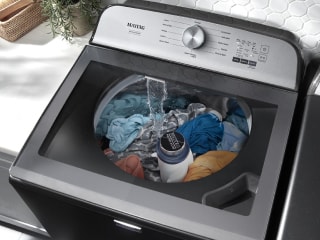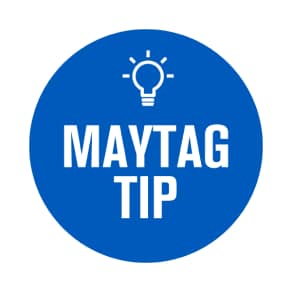
WHAT IS TUMBLE DRY?
Tumble drying is simply machine drying rather than line drying or laying flat to dry. This method is called “Tumble Dry” because clothes tumble in the dryer drum where airflow, along with heat, dries clothes quickly. But not all fabrics are made to be tumble dried—always check the care tag first.
Within the tumble dry method, you have plenty of options regarding timing, cycles and heat. Read on to learn more about when you should and should not tumble dry, along with how to tumble dry the right way for different fabric types.


WHAT ARE THE MOST COMMON TUMBLE DRY SETTINGS?
Any setting you can select on a dryer is considered a tumble dry setting. Most dryers allow you to select a time, heat level or dryness level, and sometimes you can choose a cycle where settings are predetermined, like Normal, Delicate, Heavy Duty or Quick Dry.
When you see “tumble dry low” in drying instructions, the “low” refers to heat. See below to learn more about tumble dry heat settings.


TUMBLE DRY HIGH
If your laundry care label has instructions that read “tumble dry high,” you can dry using the high heat setting or the Heavy Duty/Sanitize cycle to dry your garments. Depending on the model, these cycles can reach temperatures up to 140 degrees Fahrenheit to dry items that may take longer to dry.
USE HIGH HEAT FOR1:
Sweatshirts
Beach towels
Jeans
Heavy work clothes


TUMBLE DRY MEDIUM
When you see “tumble dry medium” on drying instructions, it means to machine dry the item on medium heat, which is usually around 135 degrees Fahrenheit. Medium heat is ideal for permanent press or wrinkle-prone fabrics like professional clothing made of synthetic fibers such as polyester and nylon.
Light, thin cotton clothes like t-shirts can also benefit from moderate heat to help reduce shrinkage. Medium heat will dry fabrics slower and gentler than high heat, helping prevent wrinkles from setting while protecting synthetic fibers which can ripple under high heat.
PICK A MEDIUM HEAT FOR CLOTHES LIKE THESE:
Button-up work shirts
Trousers or slacks
Light cotton items like t-shirts
TUMBLE DRY LOW
“Tumble dry low” means to dry your item in the dryer on a low heat setting or Delicate cycle. Low heat is usually around 125 degrees Fahrenheit and is designed for delicate items like knitwear or sheer fabrics, as well as workout clothes made of high-performance fabric like spandex and lycra.
Low heat helps protect heat-sensitive fabrics from fraying, fading, wrinkling, stretching and warping.
PICK A LOW HEAT SETTING FOR CLOTHES LIKE THESE:
Clothing with sheer fabric
Embellished fabrics
Lingerie
Workout clothes
Winter down coats and jacket shells


TUMBLE DRY NO HEAT
“Tumble dry no heat” means to dry in the dryer with zero heat. This setting may also be labeled “air only” on your dryer. It’s meant for very delicate items that cannot withstand any heat, but is most often used to freshen, fluff or remove hair and other debris from dry items between washes.
Keep in mind that tumble dry no heat will take a while, though not as long as line drying since the air movement in the dryer tends to speed things up.

COMPARE DIFFERENT TYPES OF DRYERS

MATCH YOUR DRYER CYCLE TO YOUR WASHER CYCLE
If you used a delicate, bulky or permanent press cycle to wash, choose that cycle on your dryer as well, if it’s available. If you washed in cold water, you should also probably dry with low or medium heat. Likewise, if your item was able to handle high heat in the washer, it should be able to in the dryer as well. Learn more about washer settings in this washer cycle guide.


IS AIR DRY THE SAME AS TUMBLE DRY?
Air dry is not the same as tumble dry. Some tumble dry settings use heat ranging from low to high temperatures, while air drying is a method that uses no heat. However, some dryers offer a No Heat tumble dry setting that can be used for heat-sensitive materials.
WHAT’S THE DIFFERENCE BETWEEN TUMBLE DRY VS. DELICATE?
The Delicate cycle is typically a tumble dry cycle that uses low heat. Depending on the make and model of your dryer, the cycle may be labeled Delicate, Gentle or Tumble Dry Low.

Maytag® dryers
Gentle yet powerful drying action
Let your Maytag® dryer do the heavy lifting with parts and features that get the job done
WHAT’S THE DIFFERENCE BETWEEN TUMBLE DRY VS. SPIN DRY?
The spin dry cycle is often found on washing machines, while tumble dry is a dryer setting. Spin dry cycles remove excess water from your laundry without heat by quickly spinning the items in the washer drum to extract water.
Spin dry cycles do not completely remove water from your clothes. These cycles are designed to leave clothes damp but not soaked so you can lay them out to air dry. Unless a No Heat setting is available and has been selected, tumble dry cycles use heat to dry your clothes.
CAN I TUMBLE DRY ANY TYPE OF CLOTHING?
No. Some fabrics simply can’t handle the heat or movement of a dryer. You can hang these items or lay them flat to dry. Some clothes that should typically not be dried in the dryer would be anything made with wool, cashmere, silk, lace, leather or suede.
Of course, anything labeled “dry clean only” should be taken to a professional cleaner.
CAN I TUMBLE DRY CLOTHES LABELED “DO NOT TUMBLE DRY” ON A NO HEAT SETTING?
No. If your item’s label says not to tumble dry, it’s best not to, even with zero heat. The tumbling movement could create wrinkles which will be hard to remove without heat. Tumbling without heat could also cause shrinkage after washing.
If your clothes are stiff after air drying them, try shaking them out or adding fabric softener to the wash next time. Line drying on a windy day will also help the fabric move as it dries without damaging it, reducing stiffness.
SHOP MAYTAG® DRYERS & GET THE JOB DONE
Maytag brand offers dryers with a variety of cycles and settings. With features like Extra Power, Wrinkle Prevent option and Reduce Static option, Maytag® gas and electric dryers will help you get laundry day done.
Was this article helpful? Pass it on
FIND MORE TIPS AND GUIDES FROM MAYTAG BRAND
-
 What Do Dryer Balls Do? Dryer balls help reduce drying time, soften clothes and are an eco-friendly alternative to dryer sheets. Discover how they can help you conquer laundry day.
What Do Dryer Balls Do? Dryer balls help reduce drying time, soften clothes and are an eco-friendly alternative to dryer sheets. Discover how they can help you conquer laundry day. -
 What is Maytag® Wrinkle Control? No one wants clothes to be wrinkled when they come out of the laundry. Help prevent wrinkles in clothes with the Wrinkle Control setting on your washer or dryer
What is Maytag® Wrinkle Control? No one wants clothes to be wrinkled when they come out of the laundry. Help prevent wrinkles in clothes with the Wrinkle Control setting on your washer or dryer -
 How a Clothes Dryer Works: Gas & Electric Learn how clothes dryers work: how they circulate air, how they heat clothes, how tumble drying works and how dryers sense when clothes are done.
How a Clothes Dryer Works: Gas & Electric Learn how clothes dryers work: how they circulate air, how they heat clothes, how tumble drying works and how dryers sense when clothes are done.
1 Always follow the instructions on your item's care tag.

